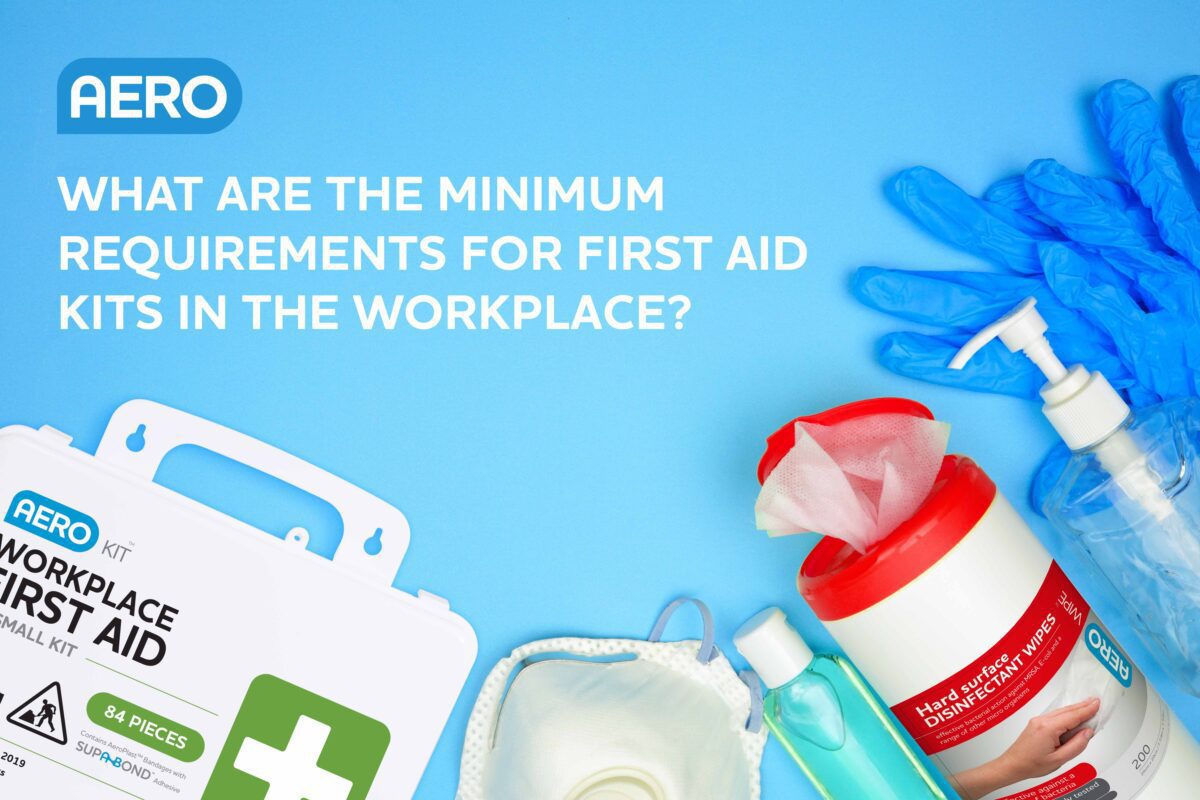Blog
What are the minimum requirements for first aid kits in the workplace?
Published 05/06/2023

Minimum first aid requirements will look different from one workplace to another. That’s why you’ll need to understand what your company needs first. We break down everything you need to know in this blog.
For over 40 years, it has been a legal requirement for employers to house, display and provide adequate first aid precautions within their place of work. The Health and Safety (First-Aid) Regulations 1981 has helped ensure employees and visitors to worksites receive appropriate first aid treatment in the event of an injury or illness.
These minimum requirement first aid solutions are designed to tackle injuries or illnesses prevalent within a particular industry, meaning that, in an ideal world, every workplace holds the exact first aid equipment it could need. However, despite HSE regulations and RIDDOR reporting in place, there were still around 565,000 reported non-fatal injuries that took place between 2021 and 2022. There’s also the likelihood that a significant portion of injuries go unreported.
Without effective reporting, it makes finding suitable first aid kits incredibly difficult for worksites, especially those with emerging risks, such as work-related disease or illness. So, how can your industry best prepare for first aid requirements and how can you ensure your workplace is safe?
Understanding minimum requirements for workplace first aid kits
First aid shouldn’t be treated as a tick-box solution. In fact, even the most basic first aid kit on the market could offer a form of life-saving treatment. However, simply resorting to the cheapest option might not be the correct action to take, especially for higher-risk industries.
Before you can purchase a first aid kit for your workplace, you’ll need to identify what the minimum requirements are.
Assess your first aid requirements
Many retailers and sellers will offer an HSE-approved first-aid kit without indicating exactly what needs it meets. That’s often where workplaces and worksites falter. Instead of spending unnecessary budget on a first aid kit that might not meet your specific needs, it’s worth breaking down exactly what your first aid requirements are.
Using your workplace’s risk assessment, you’ll be able to identify exactly what first aid needs your business has. You can achieve this by:
- Looking at the type of work completed on site
- Understanding whether multiple risks and hazards are present
- Reviewing your workforce size and amount of sites or buildings to cover
- Identifying the work patterns of staff or contractors
- Reviewing suitable first aiders and appointed persons to assist with first aid treatment
- Understanding previous incidents that have occurred on-site or prominent risks already presented within the industry
As an employer, it is your legal duty to ensure all workers are safe. This includes off-site and remote employees. That’s why you’ll also need to consider:
- Any risks or hazards presented to remote workers or those who have travelling requirements
- The location of your premises in relation to medical support
- Employees that work across a range of sites
- First aid provisions for visitors and the general public
For more high-risk industries, or industries with very specific risks, it’s possible there is a tailored HSE-approved first aid kit that already meets your needs. This is particularly true for the food and beverage industry where first aid kits must adhere to food safety requirements. You might also find that, during this stage, standard HSE first aid kits don’t meet the immediate needs of your diverse workforce. That’s where specialist first aid suppliers can support.
Appoint a responsible person to take charge
It’s important to appoint someone to take charge of the first aid kit, accessories and equipment within your workplace. Without this in place, it jeopardises your business’ ability to adhere to The Health and Safety (First Aid) Regulations 1981. That’s why your chosen first aider must also be always someone who is available. There’s no obligation for a workplace to have more than one, but it can make the administrative duties easier to bear.
For low-risk companies with less than 25 employees, it isn’t a legal requirement to have a trained first aider, but it is a really good idea to have someone confident enough to support you when an incident occurs. Many businesses now invest in first aid training for their workforce as a way to go above and beyond the minimum first aid requirements; doing so can have real impacts on your staff. For businesses that have more than 25 employees, you’ll need to review how many trained first aiders are required based on your level of risk and total number of site users.
First aid kit requirements
After completing your assessment, you should have a clear understanding of the exact issues and risks present in your workplace. Hopefully, you’ll also see you need more than just a pack of plasters to get you by. As a minimum requirement, your first aid box or case should include:
- Disposable gloves
- Sterile dressings that are medium-large in size and individually wrapped
- An assortment of sterile plasters
- Safety pins
- Triangular bandages that have been individually wrapped
- Sterile eye pads
- A leaflet that offers guidance for general first aid
Whilst these items are the basic, minimum requirements needed, it’s worth identifying if your sites have specific needs to keep workers safe. For example, where risks could include severe bleeds, such as in arboriculture or manufacturing, it’s worth ensuring that a tourniquet or trauma dressings are also present. In these circumstances, this is considered a duty of care that goes above and beyond, which many high-risk industries are choosing to embrace.
What are the minimum first aid requirements for remote workers and travellers?
For remote workers, in low-risk jobs, that are stationed at a desk, there is no need for any first aid equipment to be supplied besides the regular domestic requirements. Regular welfare checks and risk assessments are still advised to ensure remote workers feel supported and healthy.
Companies that are centred around logistics and haulage, transport or even travelling salespeople, will need first aid provisions to cover those on the road. As a significant portion of the day is spent travelling, it’s a good solution to invest in compact first aid kits that can sit within the car or vehicle.
How can your first aid kit deliver duty of care to employees?
After the above points have been reviewed and assessed, it’s up to you if you want to deliver an even greater duty of care to your employees within your first aid kit. As part of employment law, it is an employer’s responsibility to keep the workforce safe. In some circumstances, where hazards are known, this can require employers to take greater control of their first aid provisions and deliver more support. That’s why delivering more than minimum requirements is actually the better choice.
Consider first aid training and courses
In some instances, employers may not be legally obligated to train their appointed first aiders, but it renders the act pointless without it. Having appointed first aiders throughout an organisation ensures there is someone who feels confident and responsible to deliver treatment if an injury or illness occurs. Cascading training down to your wider teams could also open up excellent opportunities for first aid awareness and hazard perception amongst your workforce.
Training and simulation are excellent solutions when it comes to learning life-saving basic first aid skills. Organisations, such as British Heart Foundation, offer CPR and first aid training sessions for workplaces across the country to boost first aid knowledge and further understanding of life-saving skills.
Identify personal requirements
Amongst large workforces, there are often more diverse groups of people. Therefore, it’s possible that a basic first-aid solution is not suitable. Take individuals with latex allergies as an example. For a first aid kit that only houses latex-based plasters, this can cause significant discomfort and possibly result in a worker hiding the injury.
On a more extreme scale, there are also various first aid-related issues that come with an ageing or male-dominated workforce. Some employers may choose to adopt a Heart Safe approach by implementing defibrillators across their worksite in the event of sudden cardiac arrest. Others may look at structural changes to the workday to ensure regular breaks and high-stress activities are followed by calming or focusing time.
Be aware of emerging threats
Emerging health and safety threats are developing all the time. These can range from musculoskeletal complaints caused by incompatible furniture to psychosocial risks attributed to life stresses, such as job security. Being vigilant of these issues can make a difference to the health and safety experience within your workplace.
Need support with finding a first aid kit that works for your business?
Whether you’re looking for an ideal solution for low-risk jobs or need to go above and beyond for your employees, Aero Healthcare has the right choice for you. Our dedicated account managers are on hand to assist you.
Contact us today!Share this article

